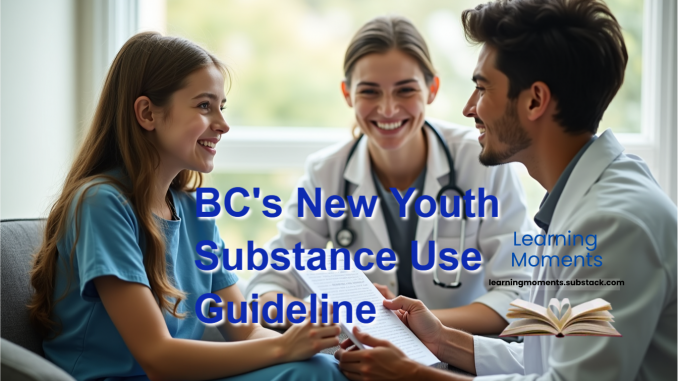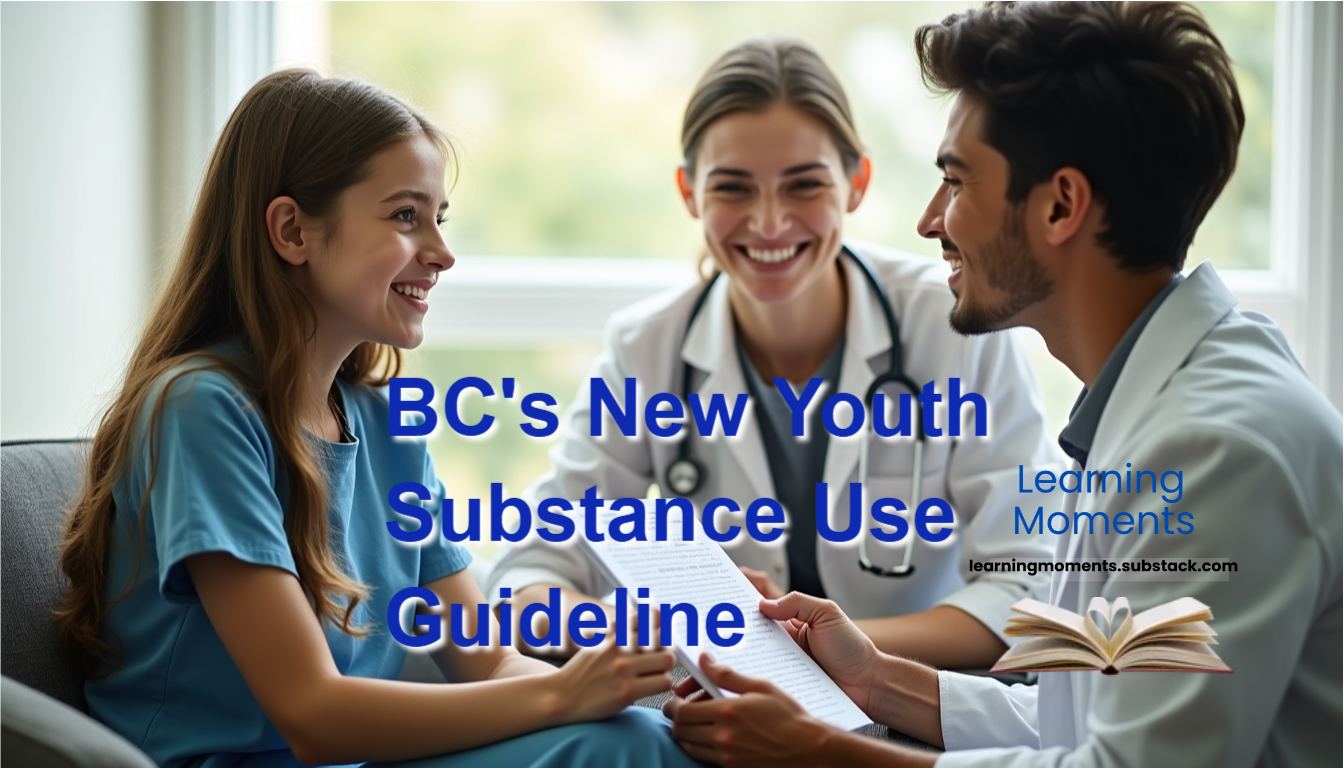
From Judgment to Compassion: BC’s Ground-breaking New Approach to Youth Substance Care
by Ron Merk Jun 09, 2025 – Visit his Substack here

British Columbia has just released a groundbreaking new guideline that could fundamentally change how young people dealing with substance use issues receive care. The Provincial Child and Youth Substance Intoxication and Withdrawal Guideline for Acute Care Settings isn’t just another medical document – it’s a bold reimagining of youth healthcare that puts Indigenous rights, trauma awareness, and respect for young people at its very center.
Best of all, the guide includes a comprehensive list of resources that can be used by families and professionals. More on that later.
Can’t wait? Read the new Guideline here.
Did you know the Provincial Health Authority has a huge library of resources available to you? Check it out at: https://shop.healthcarebc.ca/phsa/document-index
Breaking Down Barriers from the Start
What makes this guideline immediately different is how it begins. Rather than diving straight into medical protocols, it opens with a powerful land acknowledgment and a commitment that might surprise many readers: “We are committed to eradicating Indigenous-specific racism and advancing Indigenous cultural safety and humility.”
This isn’t just politically correct language – it’s a recognition of a harsh reality. Indigenous youth in BC face disproportionate challenges with substance use, often rooted in generations of colonial trauma, systemic discrimination, and disconnection from their cultures. The guideline doesn’t shy away from this history. Instead, it makes addressing these inequities a cornerstone of proper care programs.
This approach recognizes that for years, healthcare has often treated symptoms without addressing root causes. The guideline finally acknowledges that you can’t separate a young person’s substance use from their lived experience of racism, trauma, and systemic barriers.
A New Way of Thinking About Young People’s Rights
Perhaps most revolutionary is how the guideline treats young people not as passive patients, but as individuals with rights and decision-making capacity. Under BC’s Infants Act, minors can consent to their own medical treatment if they understand what’s involved – and this guideline takes that seriously.
The concept of “Best Interests” gets redefined here. It’s not just what doctors think is medically best, but what considers the young person’s wishes, culture, belief systems, and chosen supports. For Indigenous youth, this explicitly includes maintaining connections to their community, traditions, customs, and language.
This represents a move away from the paternalistic ‘doctor knows best’ approach toward recognizing that young people are experts in their own lives.
Harm Reduction: Meeting Youth Where They Are
One of the most significant shifts in the guideline is its embrace of harm reduction. Traditional approaches often focused on getting young people to stop using substances entirely. This new approach acknowledges an uncomfortable truth: abstinence isn’t realistic or appropriate for everyone.
Instead, harm reduction focuses on keeping young people as safe as possible while they navigate their relationship with substances. This might mean teaching someone how to use more safely, providing naloxone kits, or connecting them with drug checking services.
The guideline lists practical harm reduction strategies that might have seemed radical just a few years ago: encouraging safe environments for use, advising against using alone, starting with small amounts, avoiding mixing substances, and using apps like the Lifeguard Application for those who do use alone.
The approach focuses on building trust with young people. When healthcare starts from a place of judgment and demands immediate abstinence, many young people simply disengage from care. When providers meet them where they are and help them make safer choices, youth are more likely to participate in their own healthcare.
Trauma-Informed Care: Understanding the ‘Why’
The guideline recognizes something that researchers have been saying for years: trauma and substance use are deeply connected. Young people who have experienced trauma – whether from abuse, neglect, racism, poverty, or other adverse experiences – are at higher risk for developing substance use concerns.
But rather than treating this as just another risk factor, the guideline calls for trauma-informed care that acknowledges how these experiences affect brain development, emotional regulation, and social functioning. It specifically recognizes the impact of “systemic and interpersonal violence and structural inequities.”
This means that when a 16-year-old comes into the emergency room after using substances, healthcare providers are trained to ask not just “what did you take?” but “what happened to you that led to this moment?”
Fighting Stigma in Healthcare
Healthcare providers who work with young people who use substances know that stigma is often the biggest barrier to getting help. The words used can either build trust or create shame. When young people feel judged, they’re less likely to be honest about their substance use, which makes it harder to keep them safe.
A Comprehensive Approach to Assessment
When a young person arrives at the hospital with substance-related concerns, the new guideline calls for a thorough assessment that goes far beyond the medical. Yes, healthcare providers need to address immediate safety concerns and potential withdrawal symptoms. But they also need to screen for mental health issues, assess for trauma, understand the young person’s social situation, and explore their goals and motivations.
The guideline recommends specific screening tools like CRAFFT 2.1+N for substance use and various tools for mental health concerns. But it emphasizes that these conversations should happen privately, using motivational interviewing techniques rather than interrogation-style questioning.
SBIRT: A Framework for Change
Central to the new approach is something called SBIRT: Screening, Brief Intervention, and Referral to Treatment. This evidence-based approach recognizes that even a single hospital visit can be an opportunity for positive change.
Screening involves understanding where a young person falls on the spectrum of substance use. Brief intervention uses motivational interviewing to help them think about their goals and potential changes. Referral to treatment connects them with ongoing supports and services.
The key is that this process is collaborative. Healthcare providers don’t tell young people what they need to do – they help them figure out what they want to do and how to get there safely.
Discharge Planning That Actually Works
Traditional discharge planning often meant handing someone a list of phone numbers and hoping for the best. This guideline calls for something much more comprehensive and collaborative.
Discharge planning should begin when the young person arrives, not when they’re about to leave. It should involve the young person and their chosen supports in setting goals and should be holistic – addressing mental, physical, spiritual, and emotional needs.
The guideline emphasizes “warm handovers” to community services, meaning actually connecting the young person with supports rather than just providing referrals. It also requires completion of a safety plan if there are ongoing concerns.
Resources and Real Support
One of the strengths of the new guideline is its comprehensive list of resources for both healthcare providers and families. These range from clinical resources like the BC Centre on Substance Use guidelines to family supports like Foundry centers and online resources.
Importantly, the guideline includes specific resources for Indigenous communities, recognizing that culturally appropriate supports are often crucial for healing and recovery.
The Bigger Picture
This guideline represents more than just new medical protocols – it’s part of a broader shift toward more compassionate, rights-based healthcare for young people. It acknowledges that substance use among youth is often a symptom of deeper issues: trauma, racism, poverty, mental health challenges, and social disconnection.
By addressing these root causes while keeping young people safe, the guideline offers hope for better outcomes. Early implementation of similar approaches in other jurisdictions has shown positive results, with reports of increased engagement from young people and better connections to ongoing care.
Challenges Ahead
Implementing this guideline won’t be easy. It requires healthcare providers to examine their own biases, learn new skills, and sometimes spend more time with patients in already-busy emergency departments. It also requires healthcare systems to invest in training and cultural change.
Some critics worry about the emphasis on harm reduction, arguing that it doesn’t do enough to discourage substance use among youth. Supporters counter that stigmatizing approaches have failed for decades and that this evidence-based approach offers real hope for keeping young people safe while supporting their long-term wellbeing.
A Model for Others
Other provinces and jurisdictions are already looking at BC’s new guidelines as a potential model. The combination of Indigenous cultural safety, trauma-informed care, harm reduction, and youth-centered approaches represents current best practices in the field.
This guideline puts BC at the forefront of youth substance use care, representing exactly the kind of comprehensive, compassionate approach that young people and families have been requesting.
Looking Forward
The real test of this guideline will be in its implementation. Changing healthcare culture takes time, and there will inevitably be challenges along the way. But the potential for positive change is significant – healthcare that truly serves young people, respects their rights and dignity, and supports their journey toward health and wellbeing.
The guideline’s emphasis on listening to young people, understanding their experiences, and helping them stay safe while working toward their own goals represents a fundamental shift. Rather than lecturing about stopping substance use entirely, the approach focuses on harm reduction and connecting youth with people who understand their experiences.
In a province where substance use remains a significant challenge for youth, this new approach offers genuine hope for better outcomes and healthier futures.
Read the new Guideline here – Full Link: https://shop.healthcarebc.ca/phsa/BCWH_2/BC%20Children%27s%20Hospital/C-05-07-63066.pdf
Leave a Reply
You must be logged in to post a comment.